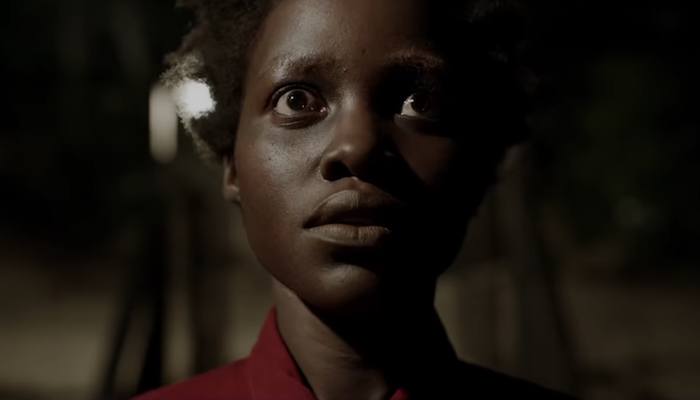By André Crous
Jordan Peele’s “Us”
For the film critic, the problem with twist endings is that it is frowned upon to dwell on that final revelation, despite their importance to the experience. Even just mentioning that there is a last-minute information dump that causes us to rethink the entire film is often too much for the reader to handle. It’s a fine line to walk, but neither the critic nor the reader/potential viewer should be overly sensitive, particularly if it is made clear why such information is included.
Jordan Peele’s Us ends with a labyrinthine flashback that seems to tell us everything before turning our whole notion of the story’s past upside down and then, for good measure, twisting our collective nuts one last time before the credits roll. But while the film does contain traces of this shocking development throughout, most notably in the form of a tune that is whistled, the character concerned simply does not embody the skeleton she has in her closet. The traces seem planted, while the central performance is almost unaffected. The actions do not bespeak a closely held secret, and therefore, the film will not be much more interesting the second time around. And that’s worth a mention in a review such as this.
It all starts out very peculiarly and then gets weirder and weirder until the climax in a subterranean, rabbit-filled lair. In 1986, a young girl named Adelaide visits the Santa Cruz Beach Boardwalk with her parents. At some point when they aren’t paying attention, she wanders off and into a mirror maze (in a dark twist of humour, it entices the customer to “find yourself”). She looks around for a way out but doesn’t find one. Someone appears behind her – a stranger who is as tall as she is, wears the same clothes and has the same hairstyle. But before we can see their face, the film cuts to the opening credits sequence, which involves a multitude of white lab rabbits.
Peele’s second film is a far cry from his first, Get Out, the global smash hit that somehow managed to induce in the viewer the anxiety of a psychological thriller while very clearly poking fun at supposedly liberal white Americans’ racial prejudices. In Us, whose title hints at a link with the United States (a link that is ultimately very weak if not altogether obscure), he is much more interested in making a genre film than in making a statement about contemporary society.
In the present day, an adult Adelaide (Lupita Nyong’o) is just settling in for holiday with her family at a cabin. Husband Gabe (Winston Duke) is happy-go-lucky, seemingly without a care in the world, and is particularly excited about taking his children to the nearby beach in Santa Cruz. This news, a close-up reveals, hits Adelaide like a ton of bricks. But she puts on a brave face for her children, Zora and Jason.
The same night, after the visit to the beach, a mute family of four appear in their driveway. But it’s not just any family – it’s their doppelgängers: four individuals who have features very similar to theirs but are wearing crimson-coloured clothing. In addition, each of them is armed with a golden pair of scissors. Only one of them speaks, albeit with great difficulty and a voice that sounds like someone who is always being strangled: Adelaide’s alter ego, Red, who is quickly revealed to be the mastermind behind an uprising from the underworld.
This underworld consists of underground walkways alluded to in the film’s epigraph, which informs us of “thousands of miles” of tunnels beneath the continental United States. The characters down below mostly behave in a way that mirrors their above-ground counterparts (although, curiously, that is not always the case). This intimate relationship means they are “tethered” to each other. Plato’s cave, but with sentient shadows, would be an eerie but apt comparison.
Except for the epigraph, the first real foreshadowing we get of this tethering is a stunning image at the beach, where the camera hovers straight above the action to capture the family walking in a straight line, barely visible, while seemingly attached to their giant shadows that are lifelike but take on a life of their own as animate shadows. National Geographic photographer George Steinmetz is famous for a similarly striking composition he made with camels in 2005.
Following the initial home invasion, we quickly realise that the uprising is not just limited to the family of four but extends to the entire United States. Somehow, as is all too often the case with disaster movies, the rest of the world is unaffected. The family sticks together, trying to learn from each other how best to kill the impostors, until the final act, when Adelaide races (all alone, for reasons unexplained) into the underworld to find one of her children, who has been abducted.
This is where things take on a real mind-bending dimension as we have to put all the pieces together when the film climaxes in brightly lit hallways that could very well be tethered to the hotel room at the end of 2001: A Space Odyssey. Peele hits us with the climax, then knocks us off our feet with a bombshell surprise before delivering a second body blow. It’s the Sixth Sense of horror films, but the unexpected double twist vaults the film into a league all its own.
And yet, whereas M. Night Shyamalan’s famous blockbuster both made immediate sense and elicited admiration for blinding us to something that was in plain sight the entire time, Us conceals more and thereby reveals less, even on a repeat viewing. In his effort to shield the truth from us, Peele varnished over all the details that would contributed to a richer fictional world, even at the risk of unveiling too much.
Even if it seems much more complex than it actually is, this is an original and stunningly crafted horror film.
—
Country USA
Released 2019
Director(s) Jordan Peele
Producer(s) Jason Blum, Ian Cooper, Sean McKittrick, Jordan Peele
Screenwriters Jordan Peele
Directors of Photography Mike Gioulakis
Stars Lupita Nyong’o, Winston Duke, Elisabeth Moss
Running Time 120 minutes
André Crous is a professional film critic and a member of FIPRESCI. He holds a French honour’s degree, two master’s degrees and a Ph.D. His research examined the works of Francois Truffaut, Mikhail Kalatazov, Martin Scorcese, Paul Thomas Anderson and Michael Winterbottom. He writes about movies in his blog, Celluloid Paradiso and lives in Prague, Czech Republic. | Read More ⟩



